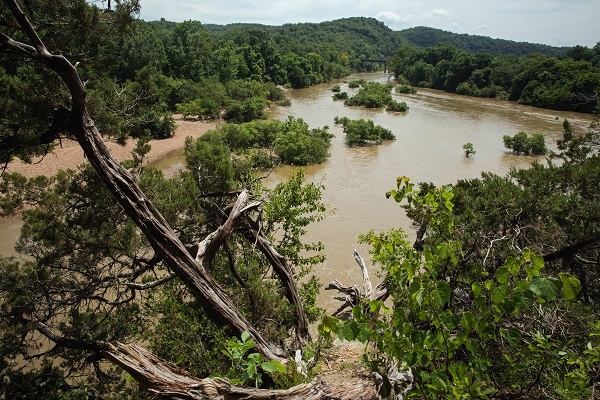News Release
You are viewing ARCHIVED content published online before January 20, 2025.
Please note that this content is NOT UPDATED, and links may not work. For current information,
visit https://www.nps.gov/aboutus/news/index.htm.

T. Fondriest/NPS Photo
|
Subscribe
|
Contact: Caven Clark, 870-365-2790
Visitors to Buffalo National River often asked questions about the quality of the water, including “Is it safe to drink?” and “What’s with all the algae?” The park reminds all visitors to be aware of their surroundings and use best practices on the river, so everyone has a safe and enjoyable visit.Is it safe to drink water from the Buffalo River, tributaries, or springs?
The Centers for Disease Control (CDC) recommends against swallowing water while swimming or drinking untreated water. The water flowing in the Buffalo River includes sources far beyond the park’s boundaries, so the quality of a certain water source cannot be guaranteed at any given time. Pathogens (contaminants that can make you sick) levels can change from day to day for a variety of reasons, especially rainfall events. Some basic rules should be applied at all times:
● Make sure water is treated and/or filtered before drinking it. Consuming water that has not first been treated and/or filtered may put you at risk of becoming sick from pathogens that naturally occur in some water bodies.
● Do not assume that it is safe to drink untreated water even though you drank it in the past and did not get sick. Next time, you may not be so lucky!
● Not all filters and treatment methods are equally efficient. Research the ones that are most effective for your needs.
What about the algae?
The Buffalo River has experienced significant algae growth this summer, but the park has not confirmed any cases of illness directly linked to algae. Blue-green algae occur naturally in many lakes and rivers across the country. Algal blooms are the result of many factors including warmer water temperatures and an influx of nutrients, such as phosphorus. The hottest and driest months of summer, when people are drawn to the river, is when the problem is most likely to occur.
Some algae is important to a healthy ecosystem and most species are harmless, although a nuisance to paddlers, swimmers, and fishers. However, the CDC notes that some species of algae are toxic to humans, animals, and the environment. Exposure to cyanotoxins or cyanobacteria from harmful algae can result in serious health problems. As a rule, areas with visible algae concentrations should be avoided for primary contact such as swimming. Avoid ingesting the water around these blooms, being especially careful if children are in your group. Dogs are also very susceptible to algae toxins. For more information, go to the CDC’s website at https://www.cdc.gov/habs/
What are we doing about it?
The National Park Service (NPS) routinely monitors water quality at 32 sites along the river, and has done so since the 1980s. Some of the parameters that are measured include E. coli, fecal coliform, turbidity, nutrients (nitrogen and phosphorus), water temperature, conductivity, pH, and dissolved oxygen. Shorter-term projects are conducted as the need arises. The NPS has a certified laboratory where many of the samples that are collected are processed, and some samples are sent to outside laboratories for analysis.
In response to this summer’s significant algae growth, a sampling and monitoring project begins next week in a partnership with Arkansas Department of Environmental Quality(ADEQ) and the US Geological Survey (USGS). The project includes mapping and sampling areas to determine what species of algae are present. The results of this study will help direct future actions relative to managing potential health risks to visitors and overall impacts to water quality.
ADEQ has created an app to report nuisance and harmful algae blooms. A person may also submit the form online:
● Nuisance Algae Bloom Complaint Form:
https://www.adeq.state.ar.us/
● Harmful Algae Bloom Complaint Form:
https://www.adeq.state.ar.us/
Please note that entities other than the NPS, ADEQ, and USGS also release water quality data. E. coli readings that may appear on social media and other sources are examples of citizen science. The processes used for analyzing these readings can take from three to five days. By the time the results are posted, the concern may have passed.
There is no “real time” information available, so the best advice is to understand the mechanics that create a higher likelihood of bacteria levels in the water. If there has been a rain event, expect higher risk. If the water is cloudy, expect a higher likelihood of risk. Avoid contact with water if you have cuts or open wounds. And never consume untreated water, regardless of whether you know the E. coli levels are high or not.
These unfortunate algae blooms and the presence of E.coli and other bacteria are not limited to Buffalo National River or to the Ozarks Plateau. Reports of similar problems can be found virtually everywhere. Concerned citizens, communities, and agencies are working together to better understand the sources of the problems, determine the potential risks, and evaluate the best practices for eliminating or managing the threats. People who love the river need to make important decisions to insure a safe and enjoyable summer by understanding these basics on water quality and algae.
Last updated: July 19, 2018
